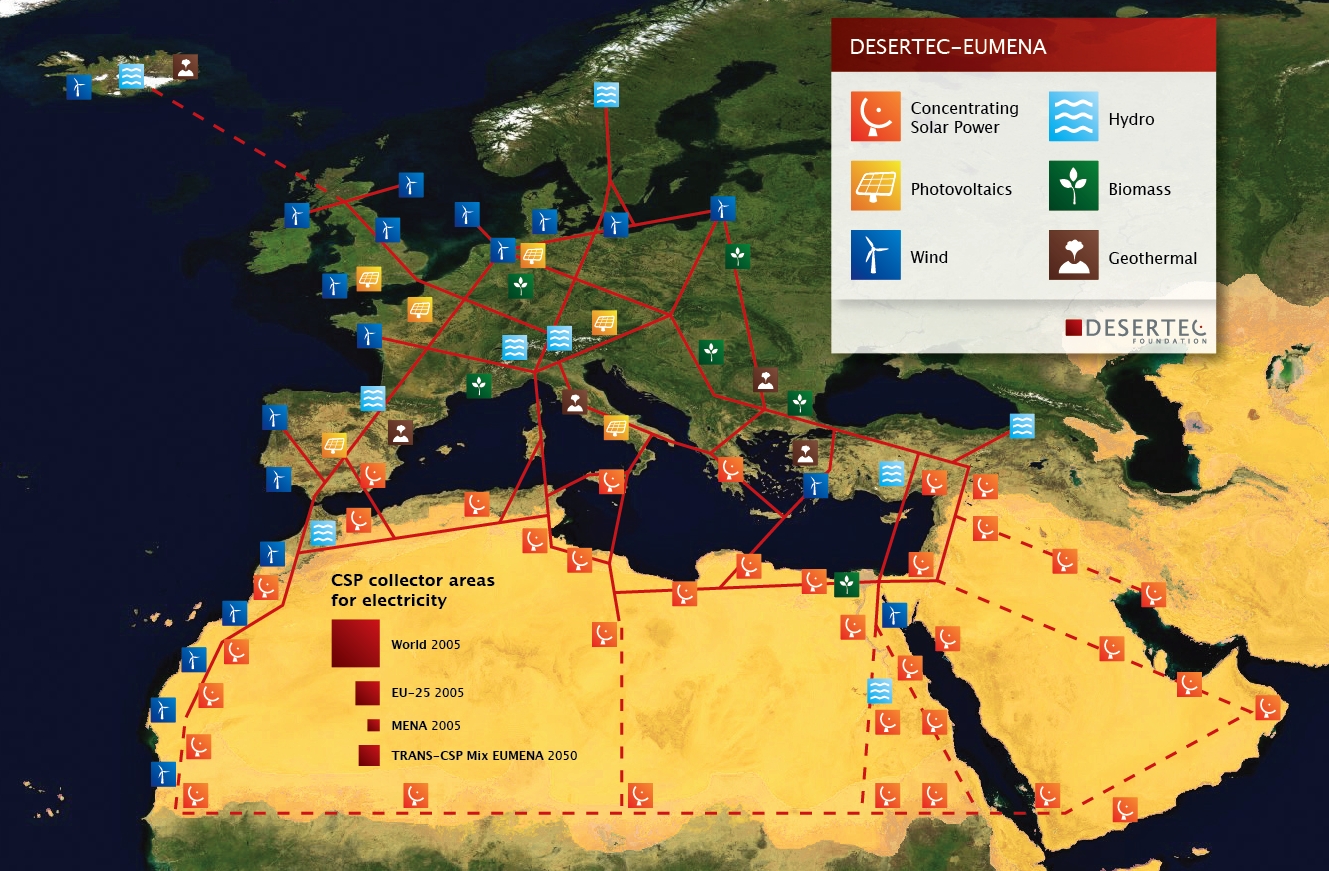Harnessing the powerful sunlight over the Sahara Desert could provide renewable energy that reduces carbon emissions and provides fresh economic value to the largely deserted area, analysts said.
As global energy demand increases, scientists are looking more seriously at how to convert the scorching heat of the Sahara — which spans 9.2 million sq.km — into energy through large solar farms and then transfer it to the rest of the world.
Efforts to tap into solar energy from the Sahara have been in the works for decades and are now showing promise, scientists said.
Euro-Supergrid with a EU-MENA-Connection:
Sketch of possible infrastructure for a sustainable supply of power to EUrope, the Middle East and North Africa (EU-MENA)
For illustration: the red squares indicate the space needed for solar collectors to produce the present power for the world (18.000 TWh/y, 300×300 km2), for Europe(EU 3.200 TWh/y, 125×125 km2) and for Germany or MENA (Middle East and North Africa, about 600 TWh/y, 55×55 km2). The square labelled «TRANS-CSP Mix EUMENA 2050» indicates the space needed for solar collectors to supply the needs for seawater desalination and about two-thirds of the electricity consumption in MENA in the year 2050 and about one-fifth of the European electricity consumption by Concentrating Solar Thermal Power Plants (2,940 TWh/y in total).
Euro-Supergrid mit einer EU-MENA-Connection:
Skizze einer möglichen Infrastruktur für eine nachhaltige Stromversorung in EUropa, dem Nahen Osten (the Middle-East) und Nord-Afrika (EU-MENA)
Zur Veranschaulichung: Der durch die roten Quadrate markierte Platzbedarf für Solarkollektoren würde theoretisch genügen, um in Solarthermischen Kraftwerken (CSP) den Strombedarf der Welt (18.000TWh/y, 300×300 km2), Europas (EU, 3.200 TWh/y, 125×125 km2) und von Deutschland bzw. MENA (Middle East and North Africa, ca. 600 TWh/y, 55×55 km2) zu erzeugen. Das Quadrat «TRANS-CSP Mix EUMENA 2050» zeigt die insgesamt benötigte Fläche für Solarkollektoren, um den Bedarf an Meerwasserentsalzung und zwei Drittel des Strombedarfs in MENA im Jahr 2050 mit Solarthermischen Kraftwerken zu decken und etwa ein Fünftel des europäischen Strombedarfs (zusammen 2,940 TWh/y).
In 2009, the Trans-Mediterranean Renewable Energy Cooperation started Desertec, a project designed to harness solar energy and transfer it via high-voltage direct current. While the project initially gained significant interest from energy firms and banks, it collapsed in 2014 because of prohibitive costs.
“Costs were very high and some companies said we’re not that interested in the Middle East and North Africa,” Desertec CEO Paul van Son later explained.
A similar solar power project is TuNur, which aims to open an energy corridor between North Africa and Europe by linking the Sahara-developed power to Europe’s energy grid. The project is expected to reinvigorate the energy market and stimulate the economy of Tunisia, a central partner.
A parallel step came in April, when Tunisia and Italy reached a deal to construct an underwater energy line between Partanna, Sicily, and El Haouaria, Tunisia.
Solar energy can be turned into electricity through two main methods: the indirect use of concentrated solar power through reflective surfaces and, more commonly, photovoltaics, which converts sunlight to energy through semiconducting materials, such as solar panels.
Each technique delivers a large amount of energy to a specialised area but also has distinct drawbacks. Both methods, for instance, are highly vulnerable to sandstorms, which are common in the Sahara.
Photovoltaic technology has another problem in the Sahara, where temperatures routinely exceed 40 degrees Celsius — solar panels simply get too hot to function effectively. Concentrated solar farms are more frequently used in the desert.
Given the Sahara’s size, experts agree it is a prime location for solar farms. Estimates from NASA and calculations by Amin Al-Habaibeh, of Nottingham Trent University, indicate the area produces more than 22 billion gigawatt hours of energy per year that could be harnessed.
This is equivalent to the amount of energy produced by 35 billion barrels of oil a day, meeting “7,000 times the electricity requirements of Europe, with almost no carbon emissions,” Habaibeh said in May in an article for the Conversation.
Even after energy is collected, there are problems with transporting it. Previously, this was done through storage batteries but those were cumbersome and frequently lost energy.
Researchers from Chalmers University of Technology in Sweden are developing a “molecular solar thermal system” that stores energy as a chemical fluid, resulting in no loss of the storage medium.
“The technique means that we can store the solar energy in chemical bonds and release the energy as heat whenever we need it,” said Kasper Moth-Poulsen, who leads the research team. “Combining the chemical energy storage with water-heating solar panels enables a conversion of more than 80% of the incoming sunlight.”
Despite continuing roadblocks, the Sahara Desert has remarkable potential to revolutionise the global energy market, providing an effective, renewable solution with a limited carbon footprint.
